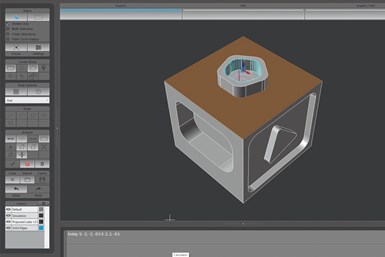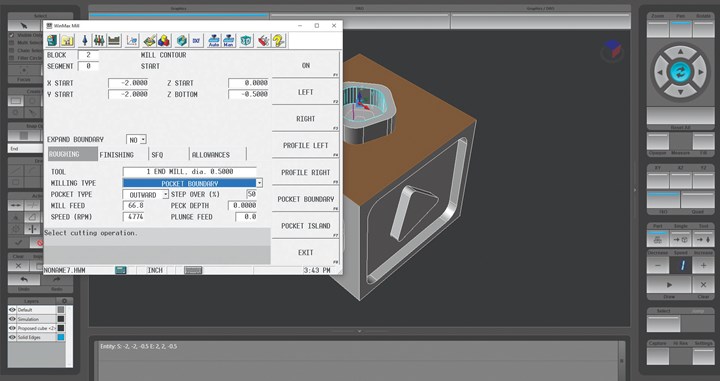Can You Pull Data From a Solid Model to Perform Five-Axis Conversational Programming?
A CNC feature imports a 3D solid model from which operators can perform conversational-type, five-axis programming.
#techbrief

Users can position solid models to view the features to be machined. For a pocket, the user would select its floor and top, and the depth is automatically pulled from the model. (Photo Credits: Hurco)
CNC conversational programming software enables machine tool operators to create part programs directly at a machine’s control by answering prompts for information that defines the part and the requisite operations to complete it. The control then automatically creates the NC program in the background. G-code knowledge and what can be time-consuming, line-by-line programming are unnecessary.
In the past, this type of programming was used for relatively simple part geometries or for programming parts defined only in 2D prints. Increasingly, though, design engineers are able to supply shops with 3D solid models of the parts they need to be machined. Machine tool builder Hurco says, as a result, its customers have been asking for a means to create part programs conversationally directly from customer-supplied solid models. This is now possible using the 3D Import option on Hurco’s WinMax CNC for three-axis work or five-sided machining.
Featured Content
Once a model (an .stp file) is imported, it can be oriented on the control screen to view specific features to be machined.

A window such as this enables users to input cutting parameters to complete each program block.
Take a pocket as an example. A user selects the floor of the pocket, then identifies the top of the pocket. The pocket depth is automatically pulled from the model. The user then makes selections such as type of tool, climb or conventional machining to complete the program block for that feature. Because 3D Import can also automatically calculate transform planes, it can create programs to machine five sides of a part on a five-axis machine.
In addition, this feature can gather Z-axis depth information from 3D .dxf files, and it offers the capability to program directly from splines (curves that can be shaped in CAD by manipulating points) without traditional editing for missing geometry.
RELATED CONTENT
-
CNC Apps You Possibly Didn’t Know You Could Benefit From
Some software capabilities go underutilized. One machine tool builder’s CNC software includes lesser-known apps that shops can leverage to their advantage.
-
Manufacturing Automation Beyond Robots at PMTS
A variety of automated machining and manufacturing processes — including, but not limited to, robotics — that can enable shops to become more efficient were on display at the recent Precision Machining Technology Show.
-
When CNC G-Code Programming Is a Must
In some cases, G-code programming is preferred over conversational programming, although they can be complementary processes.






